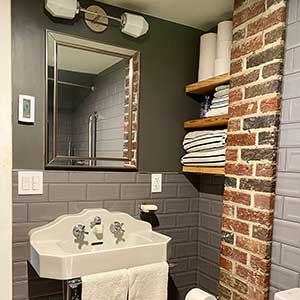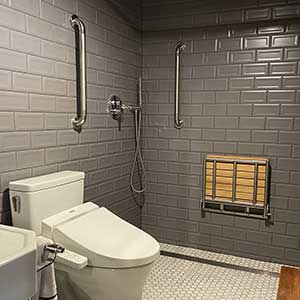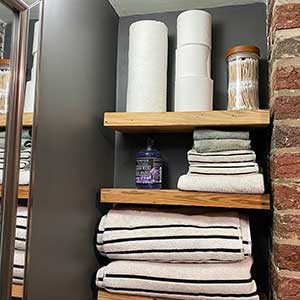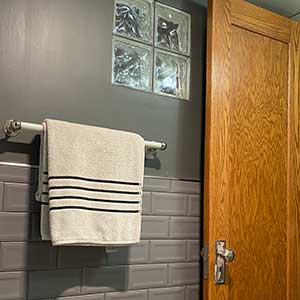Using salvaged materials in a renovation project is not only budget- and earth-friendly, but also eye-friendly as well! This bathroom in the home of Mariam d’Eustachio, Community Forklift’s Director of Administration, is a perfect example of how reused and upcycled materials can come together to create a high-end feel on a low-end budget. Can you tell which materials came from Community Forklift? Here’s a rundown:
• vintage door and door hardware
• vintage soap dish
• American Standard commercial sink and legs from 1928
• high-end Portuguese ceramic wall tile
• glass blocks for the window
• vintage milk glass towel bar
Plus, the reclaimed heart pine for the shelves is from Brick + Board and the bench is upcycled deck seating!
“The design evolved around all of these reusable items we wanted to incorporate,” Mariam wrote in a blog post. “Not only is it a sustainable option to include reclaimed items in your renovations, but it is affordable. The quality of these older materials are not what you find in newer items made today, unless you are prepared to go for broke.”
Mariam has a few tips on how to incorporate salvaged materials into your renovation project.
1) Have an open mind. Instead of going into your project with a set-in-stone vision of how you want it to look, check reuse stores for what is available and let that inform and guide the direction of your design.
2) Be flexible and creative. When looking at salvaged materials, consider all of your options and figure out how you might use them in your room. Could salvaged flooring be made into shelves? Would a garden bench work in a bathroom?
3) Talk to your contractor about using salvaged materials. Some contractors won’t work with reused and upcycled materials, so look for a craftsman who is willing and experienced in doing so.
If you’ve got a repair or renovation in the works, give reuse a try!
***
Every time you donate or shop at Community Forklift, you’re helping us lift up local communities through reuse. We turn the construction waste stream into a resource stream for communities in the DC region – by keeping perfectly good items out of the landfill, preserving historical materials, providing low-cost building supplies, and creating local green jobs.





